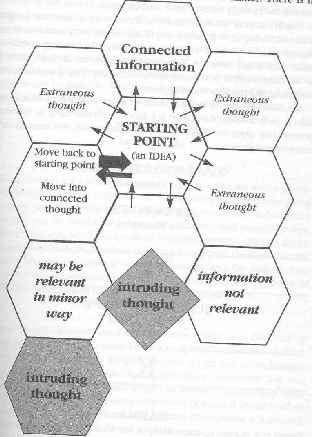
Trust Your Hunches
- the process of intuition
by
In one sense intuition means teaching oneself through the use of insight. Many people have likened it to a quantum leap, a huge surge in understanding, and a sharp change in perception. It is as though the mind lies quiescent for a time, and then suddenly is galvanized into action, in a flash producing the answer to whatever conundrum is being considered. Psychologists would have us believe that the unconscious mind takes over the consideration of a problem, and works on it independently of the conscious mind. That is why the awareness of it that operates in the hypnagogic and hypnopompic states is so invaluable, because the insight is often caught in those states. These states involve a change of consciousness and are an invaluable tool in creativity. Just as it is possible to train oneself to dream lucidly, it is also possible to harness the energy of these states.
Thinking too hard about the intuitive function seems to block it, because the rational mind is not able to accept the knowledge as valid. It could be said that intuition is the drawing to oneself of information one could not consciously know, but perhaps it might also be said to be a linking with the collective unconscious or with the soul level in order to take correct action . . .
The first step in training one's intuition is to trust one's hunches. Almost everyone has experienced the feeling of knowing that something is going to happen. The salesman who knows he has made a sale, the mother who knows something is not quite right with her child, or the lover who senses his girlfriend's withdrawal - are all using intuition.
Secondly, put these hunches on record. Whether you talk about them to friends, or make a note of them, does not matter. There is no mystique about this; the process only tells you how many times you get things right and how many times you get them wrong. As with clairvoyance, you will gradually be more right than wrong and you will increasingly learn to trust your intuition.
Thirdly, as your hit rate improves, try to work around the insight. Without trying to rationalize anything, allow your mind to open up slightly to possibilities around the subject If anything comes to mind, note its relevance and move on. Then come back to the original thought, allow it to become central again and continue the process. The process looks something like this illustration:

Intuition consists in making use of the whole information available. A well developed intuition is a kind of filing or ordering process that gives you instant access to information which has already been received and stored within the great unconscious.
![]()
[1] Pamela Ball has been in the "business" of personal development for more than thirty years, during which time she has been a professional dream counsellor and has advised and guided countless people including leading figures in business, politics, and the arts. She lives in Berkshire, England, and is the author of several books - mainly on the subject of dream interpretation and other esoterica. This article is based on a section of her book 10,000 Ways to Change Your Life (Arcturus Publishing, 1997).
[2] Hypnagogic. When they are between wakefulness and falling asleep some people are conscious of voices and see mental pictures or visions. These hypnagogic images can seem to invade our awareness without conscious effort. Music may also be heard. Such images and sounds may prove creative and enlightening. The hypnagogic state is regarded by many as a route into the paranormal, and information received at such a time is often precognitive.
[3] Hypnopompic The sounds and visions that arise during the transitional state between sleeping and waking consciousness, (the opposite of hypnagogic state) are called hypnopompic images. In such a state the individual is highly sensitive to psychic vibration of all sorts. This may explain many precognitive and certain déjà-vu experiences.